
Solar Dryers For Fruits And Vegetables
Grekkon Limited’s hybrid solar dryers for fruits and vegetables in Kenya are designed to dry faster than the conventional or natural solar dryers. They are enhanced with cyclone roof top vents, and fans on the sides. Hybrid solar dehydrators are efficient for large- scale commercial food drying. This is especially with longer to dry fleshy food like; cassava, banana, tomato, fruits, and rice. Drying time is a factor of the food crop type, and the prevailing ambient temperature during the drying period. The quality of the dry produce is consistent. The dryer works through the greenhouse effect.
Solar Dryers For Fruits And Vegetable In Kenya
Solar Dryer Materials
- UV treated paper on the sides and roof. UV block treatment on the polythene paper extends it’s usable lifetime to 4 years. This treatment prevents UV degradation of the food crop. The polythene paper has anti-drip properties to keep dew from forming on the inside of the paper. Dew drops on the drying food will cause molding.
2. Galvanised steel support structure. Galvanised with food grade aluminum, or zinc
3. Concrete floor for the permanent/ immovable models
4. Heat absorbing and releasing dam liner to line the floor
5. Roof top cyclones. Ensures the air is evenly distributed within so that there are no air pockets. This results in evenness of drying for the produce. We install cyclone roof top vents from a particular solar dryer size
6. Fanning system. This comprises of;
- solar panels; to provide electric DC power
- a control box; to regulate electric current
- an inverter; to convert DC energy form the solar panels to AC to power the fans
- fans; an extraction fan to allow push in air, and an exhaust fan to move out accumulated moisture
7. Nets. High density UV treated nets on the air entry and exit points
8. Drying trays designed with material specific to food drying
Every material used is specific to solar dryers for fruits and vegetables to provide; efficiency, safety, and food quality
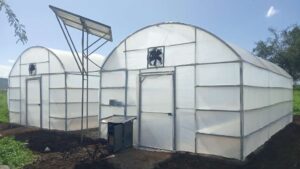
Solar drying units by Grekkon Limited in Taita Taveta county enhanced with a solar panel and battery to power cyclones, extraction and exhaust fans. They increase air movement in the solar dryer, thereby hastening the drying process, and also making it even
How To Use Solar Dryers For Fruits And Vegetables
- Chop or slice the produce into smaller pieces. This increases the surface area for drying
- Place these pieces on the drying trays
- Keep the door closed always to avoid food contamination
- Every drying 3 hours, monitor the moisture content using a moisture meter
Solar Dryers For Fruits And Vegetables
FAQs
1. What are the 2 types of solar dryers?
1.1. Passive solar dryers. They only utilise the sun’s warmth
1.2. Active solar dryers. These ar hybrid solar dryers that utilise both passive drying and biomass generated heat
2. How do you make a solar dryer?
Grekkon limited’s low cost solar dryers in Kenya are made from the following materials
2.1. A zinc or aluminum galvanised steel structure. It is rust free and easy to clean with plain water
2.2. UV treated greenhouse polythene with anti-drip properties. The UV treatment prevents food degradation by the sun’s UV rays. It ensures that the color, taste, scent, and nutritional value remains after the moisture is removed. The anti-drip treatment prevents moisture droplets from condensing on the paper and forming drop that will fall on the food. Such drops cause molding
2.3. A heat absorbent floor. his one absorbs heat during the day, and releases it at night reducing tea variance between day and night temperatures. Dew formation and mold development is aggravated by a huge difference between day and night temperatures
2.4. A UV treated heavy gauge insect net to protect the produce from insect pests. This insect net covers the air vents
For a hybrid solar dryer we add all or part of the following
2.5. A biomass combustion chamber with a pipe that carries the heat to into the solar dryer. This one is used at night when there is no sunshine, or on cloudy, cold or rainy days. It ensures continuous drying irrespective of the prevailing weather
2.6. A solar panel with a battery to power cyclones, and extraction and exhaust fan. This system speeds up the drying process by increasing air ,movement withing the solar drying chamber. And also help in evenness of drying in the chamber
3. What is the size of a solar dryer?
Your solar dryer size will be determined by the weight and volume of product dried per session. The larger it is, the larger will be your solar dryer
4. How do I choose a solar dryer size?
Grekkon Limited guides on the solar dryer size a client will need based on the produce type and drying quantity per session
5. What is the mot popular use of a solar dryer?
To cleanly extract moisture (dehydrate) from farm produce, yet retain all other qualities
6. What type of solar dryer is best?
A hybrid solar dryer is the best because it allows for continuous drying; both day and night, and on cloudy or cold days
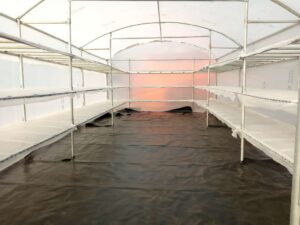
Solar Dryers For Coffee In Kenya
Solar dryers for coffee in Kenya by Grekkon Limited improve the drying efficiency of harvested coffee cherry. In Kenya, harvested cherry is largely manually open dried which takes 10 – 14 days depending on the location and the prevailing temperatures. Open coffee drying is done on wooden raised table structures with a wire mesh bed laid out where the coffee cherry is spread thinly. The coffee cherry is dried by direct solar radiation and wind movement
Cost of solar dryers for coffee in Kenya
The overall cost of a solar dryer depends on the size. The average price of a large solar dryer for coffee in Kenya is Kes 1,200/M square
Challenges of open coffee drying
- it is labour intensive. This is needed to turn it over every 45 minutes to 1 hour on the bed to ensure eveness of drying, covering it in the evening or on rainy days with a polythene cover to prevent moisture entry. This increases the cost of coffee erries drying
- quality degradation as a result of moisture entry, dirt, elements of nature, and other contaminants
- it requires lots of space because the beds cannot be designed in a storeyed manner
- none uniformity of drying because it is turned over by hand on the raised drying beds

Open drying of coffee cherries in a coffee factory in western Kenya
The key advantage of open sun drying of coffee is that it is cheap, and has zero CO2 emissions
The coffee is dried from 60% to 10% – 11% moisture level. There are six stages in cofee drying
1) Skin drying. Moisture 55-45%.
2) White Stage drying. Moisture 44-33%.
3) Soft Black stage. Moisture 32-22%.
4) Medium Black Stage. Moisture 21-16%
5) Hard Black Stage. Moisture 15-12%
6) Fully dry coffee and conditioning. 11-10%
Coffee drying is a post-harvest handling process where the coffee quality is preserved instead of improving it. Different temperature limits are allowed for different coffee processing methods. Moisture level are checked to prevent moulding on the drying coffee
Solar dryers for coffee in Kenya by Grekkon Limited provide a low cost, efficient, zero CO2 emissions, and a clean way to dry cofee cherry. The use of solar dryers mitigates against the challenges faced under open sun drying.
How does a solar dryer for coffee work?
1. Air in the dryer in contact with the coffee is heated through solar radiation
2. Moisture in the coffee beans rises and is expelled through a ventilation
The temperature in the coffee solar dryer is on or about double that of the ambient temperature
Benefts of a solar dryer for coffee
- the coffee beans are not tuned over manually to achieve eveness of drying. This cuts out the huge labor cost coffee factories incur during coffee drying. Eveness of drying is well achieved as hot air dries every bean uniformly
- there is no external mositure entry especially from rain. This removes any occurence of moulding or mildew
- coffee dries at half the time or less that it would take under direct sun drying. This reduced drying time saves on operational costs
- there are no external contaminants
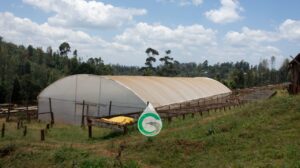
The exterior of a solar dryer built in a coffee factory by Grekkon Limited
- the polythene paper cover used has UV block treatment which preserves the quality of the coffee bean. It also has anti-drip attributes, so that dew does not form on it, then drop on the coffee
- space is eficiently used because the drying racks are stacked up over each other, unlike in open sun drying where each coffee cherry must make contact with the sun’s rays to dry
- in areas where coffee theft in factories is rampant, the solar dryer can be locked to prevent entry. This is not possible under open sun drying
- drying goes on even in hazy, cloudy or rainy conditions. Coffee is thus dried anytime of the year, creating drying efficiencies for the coffee factory
Demerits of a dryer for coffee
- it is expensive to isntall
- the polythene cover has to be changed every 3 -4 years when the UV block treatment has worn off
- it is uncomfortable to work in during the day as the internal temperature is high
- where care is not taken, over-drying of coffee may happen, which reduces its quality and its subsequent market price. A moisturemeter should always be used in the drying process to prevent this
- it requires maintainance, such as replacing the UV block treated polythene sheet every 3 years, when the UV block treatment degrades

A coffee solar dryer working principle
A conventional coffee solar dryer can be enhanced with solar module powered extraction, and exhaust fans, which converts it to a hybrid coffee solar dryer. This will further improve on the drying time as moisture is extracted faster. However, due to the large size of the unit, it is an expensive undertaking. It is largely used in smaller fish, herbs, spices,vegetable and fruit solar dryers
How to install solar dryers for coffee
- create raised tables from timber or galvanised steel not more than 1M in width. The length is as much as can be done. These tables can be storeyed upto 3 levels with vertical gaps of 0.75M – 1M between the levels. The horizontal distance from a table to another is 0.5M
- lay a food grade wire mesh over the tables to hold the coffee. A shade net or insect net can be used. The reason a perforated membrane is laid is to allow for free drying air movement on the beans
- construct the galvanised steel framework over these tables to amaximum mid height of 5M
- lay the greenhouse polythene paper over the steel frame
- place an insect net in the air entry and exit points. An insect net prevents entry of insect pests

A 2 level table bed coffee dryer by Grekkon Limited in Kagumoini area, Nyeri county
Grekkon Limited provides training on proper coffee drying in a solar dryer, and also on the maintainance and managemnt of the solar drying unit after installation to coffee societies in Kenya
(more…)
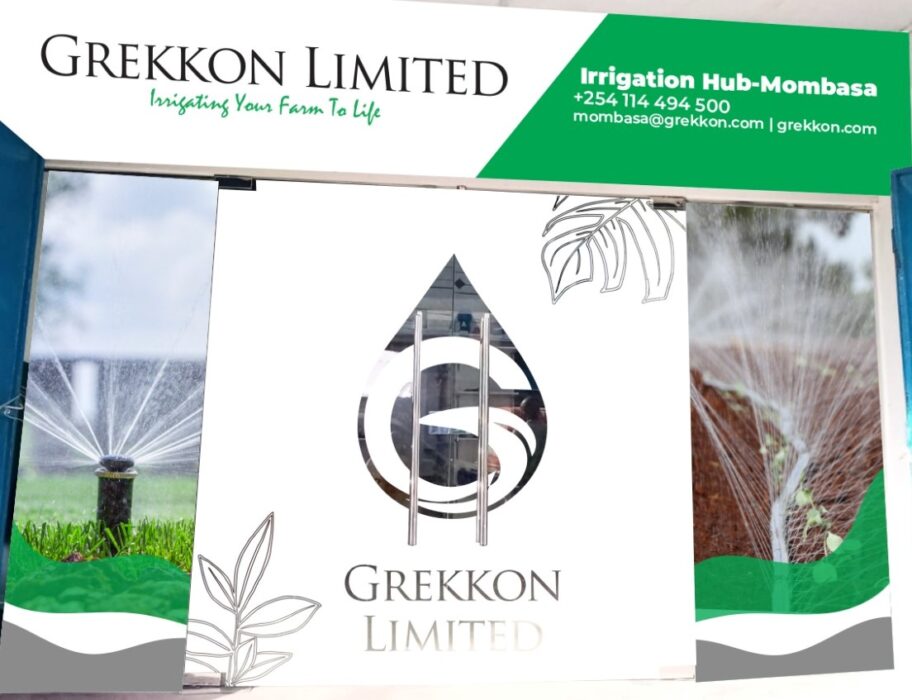
Irrigation Company in Mombasa
In commemoration of our 5 years of serving farmers, Grekkon Limited has a new irrigation company in Mombasa. Grekkon Limited – Irrigation Hub, Mombasa opened it’s doors on the 7th of February 2022. This is 5 years after the first office started operations from Nairobi. Grekkon Limited – Irrigation Hub, Mombasa is located along Jomo Kenyatta Avenue, opposite the Mombasa Pentecostal Church.
Irrigation Company in Mombasa
Products
Irrigation systems
1.1. Drip irrigation
- double emitter pre-perforated drip tapes for vegetables

tomato drip irrigation
- button drip irrigation systems for orchards, and forestry

button drip system on avocado
1.2. Sprinkler systems
- rain gun sprinklers to irrigate large diameters
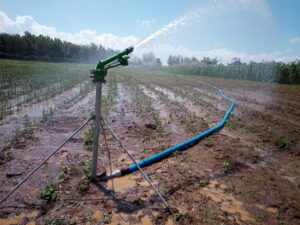
flange type rain gun sprinkler
- impact sprinklers for small to medium scale farms
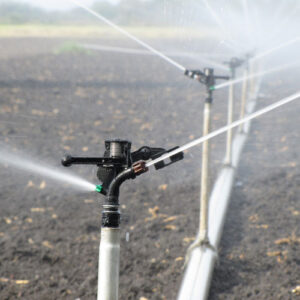
plastic impact sprinklers
- pop up sprinklers for lwans
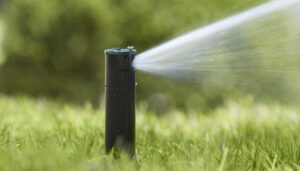
lawn pop up sprinkler
- butterfly sprinklers for small gardens and lawns
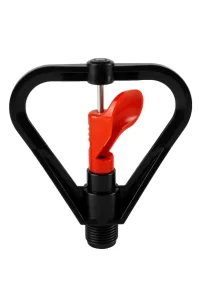
butterfly sprinkler
- meganet sprinklers
- micro sprinklers for lawns and orchards

micro sprinkler
1.3. Rain hose kits. These are pre-perforated pipes through nano technology that provide overhead irrigation

rain hose irrigation system
Every irrigation system comprises of a main line and/or a sub main line. These pipes are either high density polyethylene pipes (HDPE), polyvinyl chloride pipes (PVC), or PVC delivery pipes. Every pipe type has it’s own fittings
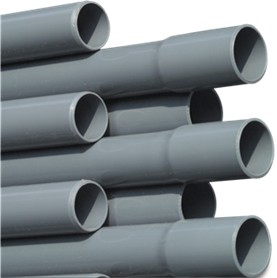
PVC Pipes by Grekkon Limited
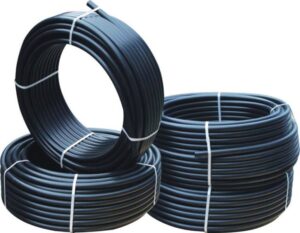
16mm HDPE pipes
2. Dam liners
These are UV treated HDPE geomembranes as;
- 0.5mm. for fine textured surfaces
- 0.75mm. for surfaces with murram
- 1mm. for rocky/ stony surfaces
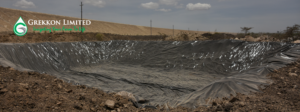
a dam liner on a reservoir
3. Greenhouses
They are categorised by shape, and/or by main frame material
3.1. By shape. They are either tunnel type which are constructed in highland or cool locations. Or vented type done in warm or mid-low altitude areas
3.2. By structural material. They are either steel or wooden. All wooden greenhouse are ‘vented types’

a steel frame, tunnel type greenhouse
4. Solar dryers
These are crop drying units made from galvanised steel with a UV treated polythene paper cover.

solar dryers in Taveta by Grekkon Limited
5. Water pumps
5.1. Solar water pumps for shallow and deep wells
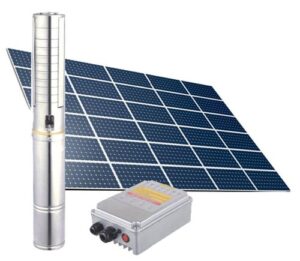
solar water pumps
5.2. Electric surface and submersible pumps

electric surface water pump
5.3. Diesel generator water pumps
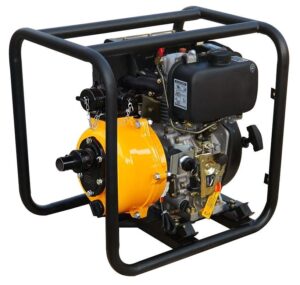
diesel water pump
5.4. Petrol generator pumps
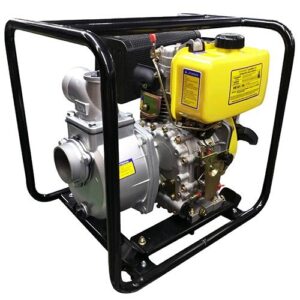
6. Agriculture nets
6.1. Shade nets. They shade the crop from excess sunlight. They are supplied as; 30%, 55%, 75%, and 90% shade
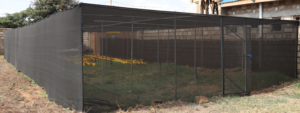
a shade net structure
6.2. Insect nets. They protect the crop from insects. They are supplied as light or heavy gauge
6.3. Bird nets. They protect the crop from bird pests
7. Planting trays and coco peat
Planting trays as; 28, 50,66, 128, 200, and 288 cells for all crops. These come with coco peat planting media
Irrigation company in Mombasa
Service
We provide tailored agronomy support service to all our farmers in east Africa. A detailed crop production hand book detailing all key aspects of crop production is given in every project
